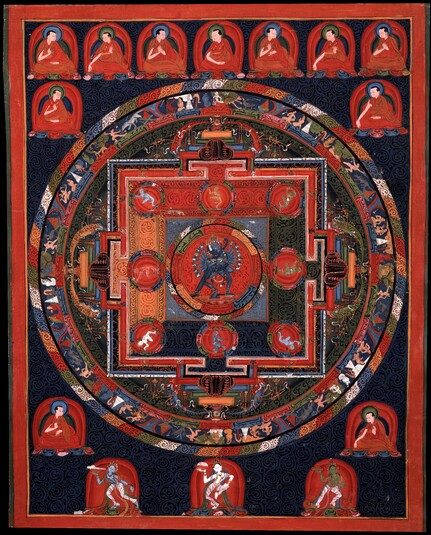
Item: Mandala of Hevajra (Buddhist Deity)
| Origin Location | Tibet |
|---|---|
| Date Range | 1600 - 1699 |
| Lineages | Sakya and Ngor (Sakya) |
| Size | 36.83x29.21cm (14.50x11.50in) |
| Material | Ground Mineral Pigment on Cotton |
| Collection | Rubin Museum of Art |
| Catalogue # | acc.# P2000.8.1 |
Classification: Deity
Shri Hevajra Nine Deity Manadala (Tibetan: pal gye pa dor je lha gu'i khyil kor): according to the lineage of Kanha.

Sanskrit: Hevajra Tibetan: Gye pa dor je
Tibetan: Gye pa dor je
Within the center of the two dimensional circular diagram (mandala) representing the top view of a three dimensional celestial palace and surroundings is the deity Shri Hevajra, dark blue in colour, with eight faces and sixteen hands holding skullcups, standing with four legs in a dancing posture. The first pair of hands embrace the consort Vajra Nairatmya (Selfless One), blue, with one face and two hands holding a curved knife and skullcup, standing on the left leg with the right embracing Hevajra. They are both adorned with bone ornaments and stand atop four corpses within the flames of pristine awareness.
Surrounding the two central figures are eight goddesses of various colours, each with one face and two hands, standing in a dancing posture on the left leg above a corpse seat. Beginning at the top and placed in a clockwise direction is yellow Vetali, multi-coloured Dombini, green Ghasmari, blue Pukkasi, black Gauri, white Shavari, red Cauri, and purple Candali. They are adorned with various ornaments and each hold their own distinct hand objects.
The floor of the celestial palace is divided into four colours ornately patterned with floral designs: red, blue, white and yellow. On the red veranda outside of the palace walls (barely discernable), on each side of the four doors ('T' shaped), are two dancing offering goddesses, sixteen in total. The outer red and white lines forming a square enclosure represent the stylized decorative facade on the four sides of the palace roof; adorned with upright spears, arrows and banners. The elaborate lintels above each of the four doors are constructed of tiered steps topped with a Dharma wheel, two reclining deer, and gold spires with a silk canopy above.
Surrounding the palace is a circle of multi-coloured (rectangular) petals representing the enormous lotus upon which the entire palace structure rests. The outer circle, divided into eight sections, containing small figures and objects is the ring of the eight great charnel grounds filled with corpses, fires, caityas, yogis, nagas, and wrathful worldly deities. The final ring is composed of the multi-coloured fires of primordial wisdom completely enveloping the entire Hevajra Mandala. Along the top are the lineage gurus for this particular mandala of Shri Hevajra.
Shri Hevajra is a tutelary deity of the Anuttarayoga Non-dual classification.
Jeff Watt 5-2003
Exhibition: Mandala, The Perfect Circle (RMA)
Thematic Sets
Collection of RMA: Ngor Style Paintings
Mandala: Iconography
Collection of Rubin Museum: Hevajra
Collection of Rubin Museum of Art: Mandala
Buddhist Deity: Hevajra Mandala (Masterworks)
Mandala: Sakya Masterworks
Mandala: Mandala Main Page
Tradition: Sakya Deity Paintings
Collection of Rubin Museum of Art: Painting Gallery 9
Buddhist Deity: Hevajra Main Page
Painting Type: Coloured Ground
Mandalas: Sakya Tradition
Collection of Rubin Museum: Mandala Masterworks
Painting Style: Ngor Mandalas
Buddhist Deity: Hevajra Mandalas
Tradition: Ngor Main Page (Sakya)

